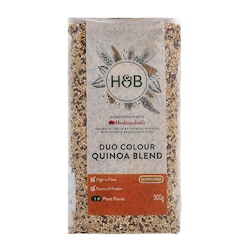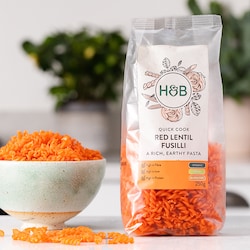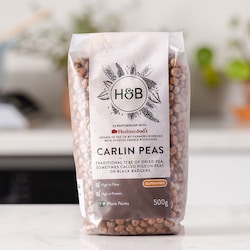15% off £20
Code:TREAT
Rice flour: Benefits, uses & side effects

What is rice flour? What are the benefits of using it in your cooking? Discover all you need to know about this versatile flour, including 9 ways to cook with it.
Summary
1Is rice flour good for health?
As we’ve already mentioned, rice flour happens to have a strong nutritional profile, which means it has been linked to several benefits; some we've...
2Is rice flour healthy for weight loss?
The effects of rice flour on weight loss is yet to be proven however, it is widely recognised that it’s a healthier alternative to refined flour...
3How to make your own rice flour
Rice flour is one of those ingredients you can make yourself. It’s also relatively easy to make too. What you need: Blender, fine-mesh strainer...
If you like rice, but can’t eat standard white or brown rice because it contains gluten/wheat or you’re looking for a new type of rice to try, then you may want to give rice flour a try.
It’s been linked to several health benefits, and if you happen to like rice, then it’s definitely worth adding to your next shopping list!
But before you do, take a look at this article, which provides you with a useful intro to rice flour, including the benefits and how to use it, as well as a recipe for making your own homemade rice flour.
What is rice flour?
As the name suggests, rice flour is a form of flour that’s made from one ingredient in particular – rice.
A fine flour, it’s 100% gluten free and a regular feature in Japanese treats, such as mochi.1 Japanese cuisine aside, rice flour can be used for many cooking and baking recipes, and happens to work particularly well as a sauce thickener and for baking.
You can get brown or white rice flour.
The white variety is made from polished white rice, while whole grain brown rice is used to make the brown variety.
As well as giving gluten-free baking structure and substance, rice flour works well in gluten baking because it has a slightly sandy texture.
Adding some white rice flour to shortbread makes the shortbread extra crumbly.
While rice flour is also known to give more volume to home-made bread because it doesn’t contain any gluten.
Overall, while not everyone may have heard of it, it’s a widely used and incredibly popular ingredient!
Summary
- Rice flour is made from brown or white rice
- It doesn’t contain any gluten
- It features in many Japanese dishes
Is rice flour good for health?
As we’ve already mentioned, rice flour happens to have a strong nutritional profile, which means it has been linked to several benefits; some of which we’ve listed below.
We’ve mentioned this a few times already, but one of the main benefits of rice flour is that it doesn’t contain any gluten because it’s made from gluten-free grains.
This makes it an ideal alternative for people who are gluten-intolerant or have Celiac disease, which is a digestive problem that affects the immune system if gluten is consumed.2
Brown flour is high in protein, with brown rice flour reportedly containing a greater amount of B vitamins too.
The reason why brown rice flour contains so much fibre is that the husk of the brain rice is left intact.
In comparison, the husk is removed for white rice production.
Rice flour, particularly brown rice flour, is high in insoluble fibre that helps our bodies get rid of waste.
This means that brown rice flour is a good thing to eat if you’re constipated and want to establish more regular bowel movements.
Eating plenty of fibre can also help lower cholesterol and maintain blood sugar levels.3
Choline, which is an essential nutrient for animals and humans, can be found in rice flour.
It plays a key role in transporting cholesterol and triglycerides from the liver and throughout the body.
As a result, it has been linked to supporting liver health.
Research carried out in 2017 on mice concluded that being deficient in choline and consuming high levels of fat can lead to rapidly progressive liver fibrosis.4
Rice flour is recognised as being a reasonably priced flour, especially when compared with other gluten-free alternatives.
This is due to the fact it’s made from an ingredient that’s in abundance.5
Rice flour happens to have a neutral flavour, which means it goes down well in most recipes because you can’t really taste it!6
Because of its slightly grainy, fine texture, rice flour can be used as an exfoliator to help slough away dead skin cells and dirt from your face or on your body.
To make a rice flour exfoliator, mix a few pinches of rice flour with honey and sugar. Keep adding water until you have a creamy mixture and then apply to your face or body using gentle circular motions.
Rinse off with warm water.7
Rice flour can help keep our bones healthy because it contains plenty of calcium – 10mg in every 100g of rice flour.
And when combined with other calcium-rich food, such as milk, cheese, tofu and nuts, rice flour can help you maintain your daily recommended intake levels.8
Rice flour can reportedly help lighten under-eye dark circles due to the fact it has a whitening effect.
The vitamin E that’s present in rice flour has antioxidant properties, making rice flour a possible solution for combating dark skin.
Create a paste, using rice flour, banana and olive oil and gently apply it to your dark circles.
Leave on for up to 5 minutes and rinse off with warm water.9
- Rice flour has been linked to numerous benefits
- It’s a great gluten-free alternative
- It contains protein, dietary fibre and choline
Is rice flour healthier than white flour?
While white flour tends to be one of the baking ingredients that people instinctively reach out for, there are some nutritional reasons why it may be worth reaching out for some rice flour next time instead.
First of all, white flour contains very little nutritional goodness because it’s high in carbs and calories and contains very few vitamins, fibre or protein.
While it may contain some nutrients, they’re removed from the white flour during processing – when the bran and germ elements of the grain are removed (as well as the goodness).
What’s more, bleached white flour is treated with chlorine gas to make it even whiter.
A 125g cup of all-purpose white flour contains:

- Calories: 455
- Fat: 1.2g
- Sodium: 3mg
- Carbohydrates: 95.4g
- Fibre: 3.4g
- Sugars: 0.3g
- Protein: 12.9g10
Many bakers prefer white flour because it contains plenty of gluten (which isn’t ideal if you are gluten intolerant), which enables their bakes to rise.
But the gluten alongside the rest of its nutritional makeup can also cause insulin spikes due to the high carb content.
So that’s white flour in a nutshell.
How does rice flour compare?
A 100g11 cup of brown and rice flour contains:
| White rice flour | Brown rice flour | |
|---|---|---|
| Rice flour calories | 366kcal | 363kcal |
| Total carbohydrates | 80.1g | 76.5g |
| Dietary fibres | 2.4g | 4.6g |
| Protein | 5.9g | 7.2g |
| Vitamin E (alpha tocopherol) | 0.1mg | 1.2mg |
| Niacin | 2.6mg | 6.3mg |
| Folate | 4.0mcg | 16.0mcg |
| Pantothenic acid | 0.8mg | 1.6mg |
| Calcium | 10.0mg | 11.0mg |
| Iron | 0.4mg | 2.0mg |
| Magnesium | 35.0mg | 112mg |
| Phosphorus | 98.0mg | 337mg |
| Potassium | 76.0mg | 289mg |
| Sodium | 0.0mg | 8.0mg |
| Zinc | 0.8mg | 2.5mg |
| Copper | 0.1mg | 0.2mg |
| Manganese | 1.2mg | 4.0mg |
| Selenium | 15.1mcg | 0.0mcg |
Brown rice flour contains slightly less calories than white rice flour, and much less than white flour.
It’s also packed full of essential minerals, making it a clear healthier alternative than white flour.
Is rice flour healthy for weight loss?
The effects of rice flour on weight loss is yet to be proven however, it is widely recognised that it’s a healthier alternative to refined flour due to its ability to boost metabolism because of its high insoluble fibre content.
The fibre in brown rice helps to reduce cholesterol levels.
It can also help prevent blood clots.12
While rice and rice flour aren’t exactly the same thing, research has found that a weight loss diet that includes rice can help people lose weight.
The study, published in 2008, gave 40 overweight women low energy meal replacements containing white rice or a mixture of black and brown rice.
After 6 weeks, it was noted that mixed-rice dieters lost 14.8Ibs and the white rice dieters lost 11.9Ibs.13
What is the healthiest type of flour?
Almond flour is definitely up there when it comes to identifying healthy flours.
Made from almonds, this flour contains many of the nutrients found in almonds.
It’s loaded with heart-healthy fats and contains twice the amount of protein and three times more fibre than all-purpose flour.
It also contains minimal carbs too!14
A ¼ cup of almond flour contains:
- Calories: 170
- Fat: 15 g
- Saturated fat: 1 g
- Protein: 24 g
- Carbs: 6 g
- Fibre: 2 g
- Sugar: 1 g
- Sodium: 0 mg
- Calcium: 66 mg
- Iron: 1 mg
- Potassium: 190 mg15
Other healthy flours include coconut, oat, chickpea and wholewheat flour.
What is rice flour used for?
Believe it or not, rice flour is an incredibly versatile flour that can be used in many different ways.
9 rice flour uses:
- Thicken soups and stews.
- Bake cakes.
- Make biscuits.
- Make fresh pasta.
- Use it as a coating for fried dishes.
- Whip up a batch of light and fluffy pancakes.
- Create a crunchy batter for dishes, such as Toad in the Hole, as well as Yorkshire puddings.
- Make thicker, richer sauces.
- Bake a batch of crusty bread.16,17,18,19
The one thing you can’t do with rice flour, is bake yeasted loaves of bread with it because it contains no gluten!
Summary
- White flour contains gluten, but it’s not as nutritious as rice flour
- Rice flour is recognised as being a healthy alternative to refined white flour
- You can use it for so many different things – e.g. baking crusty bread, making fresh pasta and thickening soups and stews
Vegan & gluten free pancakes
Rice flour is known for making pancakes that are really light and fluffy. If you like the sound of this, give this recipe for vegan, gluten-free pancakes a go:
What you need:
- 65g/2¼oz rice flour
- 65g/2¼oz tapioca flour
- ½ very ripe banana
- 300ml/10½fl oz almond milk
- 2tsp rapeseed oil or coconut oil, for frying

For the topping:
- 1½ bananas, sliced
- Large handful blueberries
- 30g/1oz pecans, toasted
- 6tsp maple syrup
- Put the flours, banana and almond milk in a food processor and blitz until you have a smooth batter. Pour the mixture into a jug.
- Heat a 20 to 25cm non-stick frying pan until hot and brush with a little oil.
- Pour in a little of the batter and swirl it around the pan to make a full-sized pancake.
- Cook for 1 to 2 minutes, or until golden at the edges. Loosen and flip over with a spatula. Cook until golden on both sides. Repeat with the remaining batter.
- Transfer the pancakes to plates and top with the bananas, blueberries, pecans and maple syrup.
- Serve immediately and enjoy!
How to make your own rice flour
Rice flour is one of those ingredients you can make yourself. It’s also relatively easy to make too.21
What you need:

- Blender
- Fine-mesh strainer
- Paper towels
- Spatula
- Large skillet
- Water sifter
- White or brown rice (uncooked – not instant)
- Rinse the rice under running water. Drain and put it in a bowl and cover it with cold water. Leave to soak for 3 to 6 hours.
- Drain the rice in a strainer for 10 to 15 minutes. Then spread it out on paper towels and let it rest for about 1 hour. The rice needs to be damp, but not wet.
- Grind the rice in your blender (gradually add in 1/2 a cup at a time).
- Start with a low setting and then gradually turn up the speed as the rice grains turns into small granules. Keep blending until everything is finely ground.
- Heat a large skillet over a medium heat.
- Add your rice flour to the pan, 1 cup at a time.
- Keep stirring it until all of the steam has evaporated.
- Cook for another 3 to 5 minutes and then remove from the heat.
- Leave it to cool down.
- Sift out any large grains.
- Store in an airtight container in a cool, dry place.
Where to buy rice flour
Are you short on time and prefer to buy your rice flour, all ready-made instead?
The good news is that it can be found in most health food shops.
Takeaway
Rice flour is a popular gluten-free ingredient that can be used for lots of different things, from baking and cooking to skincare!
More notably, it’s high in protein and dietary fibre and is low in calories. It also contains vitamin E alongside several other nutrients too.
If you haven’t tried it, give it a go, with its mild-neutral flavour you most probably won’t taste the difference, and you’ll be giving your health a boost in the process.
The advice in this article is for information only and should not replace medical care. Please check with your GP or healthcare professional before trying any supplements, treatments or remedies. Food supplements must not be used as a substitute for a varied and balanced diet and a healthy lifestyle.
Last updated: 12 October 2021
- https://bakingbites.com/2012/04/what-is-rice-flour/
- https://tailormadehealth.com/rice-flour-benefits/
- https://draxe.com/nutrition/rice-flour/
- https://pubmed.ncbi.nlm.nih.gov/28895242/
- https://fromthelarder.co.uk/white-rice-flour/#h-advantages-of-rice-flour
- https://fromthelarder.co.uk/white-rice-flour/#h-advantages-of-rice-flour
- https://facty.com/food/nutrition/10-useful-health-benefits-of-rice-flour/
- https://facty.com/food/nutrition/10-useful-health-benefits-of-rice-flour/
- https://facty.com/food/nutrition/10-useful-health-benefits-of-rice-flour/
- https://www.verywellfit.com/flour-nutrition-facts-calories-and-health-benefits-4119166
- https://www.24mantra.com/blogs/health-and-nutrition/mindboggling-facts-and-benefits-of-rice-flour/
- https://www.shawacademy.com/blog/choose-healthy-flour-for-weight-loss-best-tips/
- https://www.healthline.com/nutrition/rice-and-weight#TOC_TITLE_HDR_4
- https://www.eatingwell.com/article/7595251/the-healthiest-flours-to-use/
- https://www.womenshealthmag.com/food/a30667380/almond-flour-nutrition/
- https://www.bbc.co.uk/food/rice_flour
- https://food.ndtv.com/food-drinks/how-to-use-rice-flour-7-delicious-recipes-to-try-at-home-1456134
- https://fromthelarder.co.uk/white-rice-flour/#h-rice-flour-uses
- https://everydayglutenfreegourmet.ca/2017/07/28/how-to-use-rice-flour/
- https://www.bbc.co.uk/food/recipes/sweet_banana_and_maple_14272
- https://tailormadehealth.com/rice-flour-benefits/



































